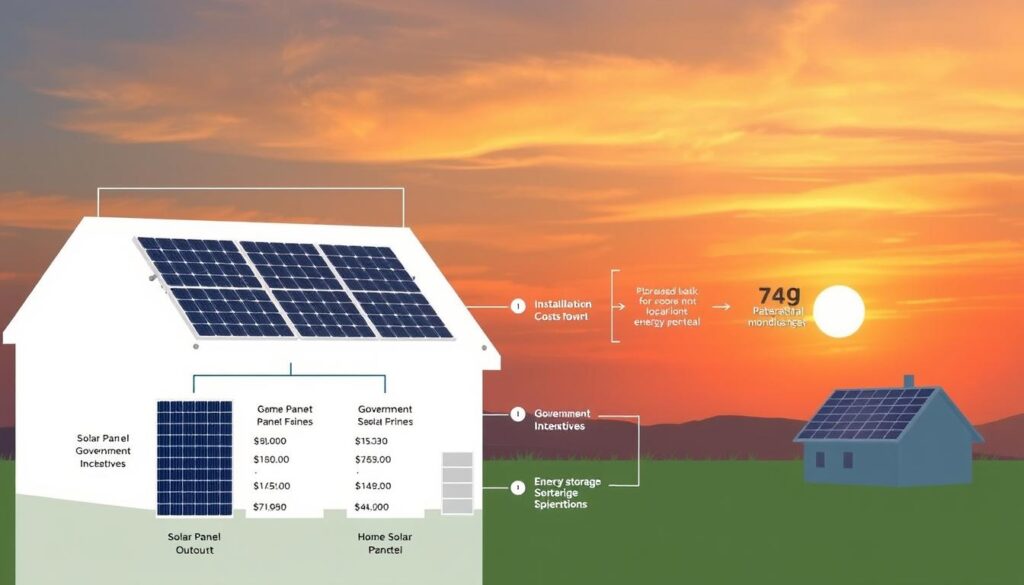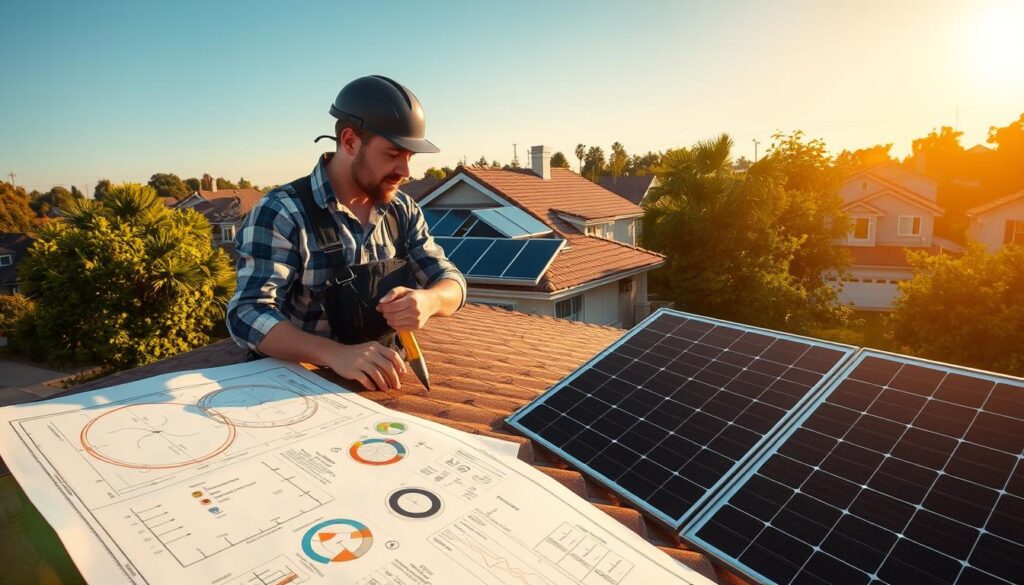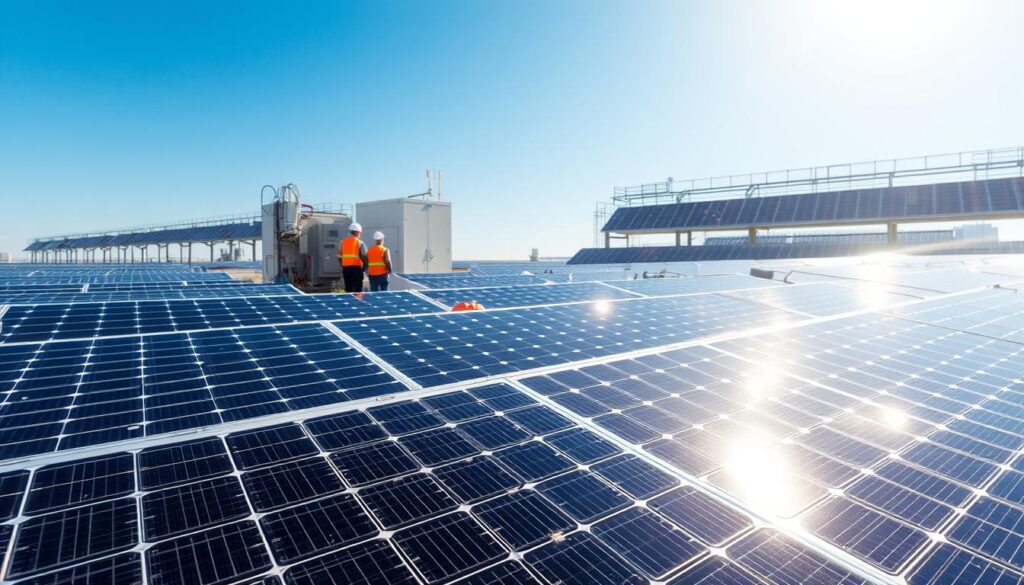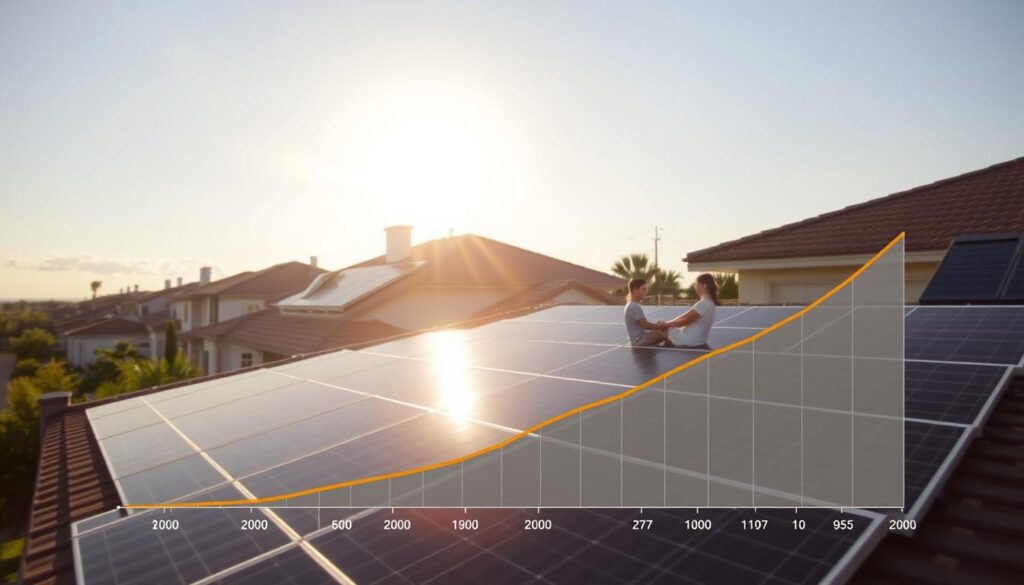Switching to renewable energy is becoming more accessible than ever. With rising electricity costs and growing environmental concerns, many U.S. homeowners are exploring affordable options to power their homes sustainably. This guide dives into the essentials of solar energy, helping you understand the costs, benefits, and available incentives.
According to EnergySage, the average cost of installing a residential solar system in 2025 is $29,360 before federal tax credits. After applying incentives, the net cost drops to around $20,552. This significant reduction makes it easier for families to invest in clean energy while saving money in the long run.
This article will walk you through the key factors to consider, including installation expenses, financing options, and federal or state incentives. We’ll also highlight the importance of comparing quotes and choosing high-quality equipment to maximize your savings and energy efficiency.
Key Takeaways
- The average cost of a residential solar system in 2025 is $29,360 before incentives.
- Federal tax credits can reduce the net cost to approximately $20,552.
- Comparing multiple quotes ensures better pricing and installer quality.
- Long-term savings can reach up to $48,000 over 25 years.
- Financing options and state incentives can further lower upfront costs.
Understanding Home Solar Panels Price
Understanding the cost of renewable energy systems is essential for informed decisions. The price of a system includes several components: equipment, labor, and available incentives. By breaking down these elements, you can better evaluate the overall investment.
Defining the Cost and Value Proposition
The upfront installation price often includes panels, inverters, and mounting hardware. Labor costs cover professional installation, ensuring the system operates efficiently. Incentives, like the federal tax credit, can significantly reduce the net cost. For example, a 30% credit can lower the average expense from $29,360 to around $20,552.
When assessing the cost-value proposition, consider long-term savings. A well-designed system can reduce monthly electricity bills by hundreds of dollars. Over 25 years, savings can reach up to $48,000, making the initial investment worthwhile.
How Pricing Reflects Energy Savings
The average cost of a system varies based on size and location. Larger systems require a higher upfront investment but generate more savings over time. Financing options, such as loans or leases, can also affect the final price.
Comparing multiple quotes is crucial. It ensures you get the best pricing and installer quality. High-quality equipment may cost more initially but performs better, maximizing your investment.
Ultimately, the price you pay reflects the system’s performance and energy savings. By understanding these factors, you can make a confident decision that benefits both your wallet and the environment.
Breakdown of Solar Panel Costs in the United States
State-by-state differences play a major role in installation expenses. The average cost of a renewable energy system can vary significantly depending on where you live. Factors like local utility rates, labor expenses, and state-specific incentives all contribute to these variations.
Average Installation Costs and Metrics by State
Installation costs differ widely across the U.S. For example, California has one of the lowest average costs at $14,476, while states like Alabama and West Virginia often see higher expenses. These differences are influenced by supply chain costs, installer margins, and regional demand.
| State | Average Cost (Before Incentives) | Cost After Tax Credit | Price Per Watt |
|---|---|---|---|
| California | $20,840 | $14,588 | $3.33 |
| Alabama | $21,047 | $14,733 | $3.42 |
| Massachusetts | $24,221 | $16,955 | $3.12 |
| North Dakota | $35,906 | $25,134 | $3.13 |
Comparing Equipment and Labor Expenses
Equipment and labor costs also vary by region. In states with higher demand, labor expenses tend to be lower due to increased competition. Conversely, areas with fewer installers may see higher labor rates. Equipment costs are influenced by supply chain logistics and local market conditions.
“Obtaining multiple quotes is essential to secure competitive pricing and ensure quality installation.”
Local utility rates and state-specific incentives further impact the overall cost. For instance, states with higher electricity rates often see faster payback periods, making the investment more attractive. Additionally, state rebates and tax credits can significantly reduce the upfront expense.
By understanding these regional differences, you can make a more informed decision about your renewable energy investment. Always compare multiple quotes to find the best balance of cost and quality.
Key Factors Influencing Solar Panel Cost
The cost of renewable energy systems is shaped by several technical and practical factors. From the type of panel you choose to the system size, each element plays a role in determining the final expense. Understanding these factors can help you make informed decisions and maximize your investment.

Panel Choice, Efficiency, and Output Rating
The type of panel you select significantly impacts the overall cost. Monocrystalline panels, known for their high efficiency, typically cost more but produce more energy in less space. Polycrystalline options are more affordable but slightly less efficient. Thin-film panels, while budget-friendly, have the lowest output ratings.
Efficiency ratings are critical because they determine how much energy a panel can generate. Higher efficiency means more power output, which can reduce the number of panels needed. This is especially important for homes with limited roof space.
System Size and Its Impact on Total Cost
The system size directly affects the total installation expense. Larger systems require more equipment and labor, but they often have a lower cost per watt. This means you can generate more energy at a reduced rate over time.
Physical limitations, like roof area, can also influence costs. If space is limited, you may need higher efficiency panels, which come at a premium. Additionally, hardware like inverters and mounting systems adds to the overall expense but ensures optimal performance.
By carefully considering these factors, you can design a system that balances upfront costs with long-term savings. Always evaluate your energy needs and roof characteristics to make the best choice.
Navigating Federal, State, and Local Incentives
Maximizing savings on renewable energy systems is easier with available incentives. These programs can significantly reduce upfront costs and improve the overall investment outlook. Understanding the differences between federal, state, and local offers is key to making the most of these opportunities.
Understanding the Federal Solar Tax Credit
The federal solar tax credit is one of the most impactful incentives available. It allows homeowners to claim up to 30% of installation costs as a credit on their federal taxes. For example, a system costing $29,360 could see a reduction to around $20,552 after applying the credit.
This tax credit is available for systems installed between 2022 and 2032. It phases down to 26% in 2033 and 22% in 2034. There’s no annual or lifetime limit, making it a powerful tool for reducing expenses.
Local Rebate Programs and Additional Savings
Beyond federal programs, many states and local governments offer additional incentives. These can include cash rebates, property tax exemptions, and performance-based rewards. For instance, New York’s Megawatt Rebate provides $2,000 for qualifying systems.
State-specific programs like Maryland’s SREC (Solar Renewable Energy Credit) can also add to your savings. Homeowners earn credits for the energy their systems produce, which can be sold to utility companies. This creates an ongoing revenue stream.
To qualify for these rebates and incentives, homeowners should consult local installers and check databases like DSIRE. These resources provide up-to-date information on available programs and eligibility requirements.
“Combining federal, state, and local incentives can drastically reduce the net cost of your renewable energy system, making it a more accessible investment.”
By leveraging these programs, you can shorten the payback period and maximize long-term savings. Always verify eligibility and stay informed about changes to these valuable offers.
Assessing Your Home’s Energy Usage and Roof Characteristics
Determining your property’s energy needs is the first step toward a sustainable future. By evaluating your electricity consumption and roof attributes, you can design a system that maximizes efficiency and savings. This process ensures your investment aligns with your energy goals and property conditions.

Evaluating Electricity Bills and System Requirements
Start by reviewing your monthly electricity bill. This data helps estimate your energy needs and the size of the system required. For example, an average U.S. household uses about 900 kWh per month, which translates to a system size of 6-8 kW.
Professional installers often compare your current usage with potential energy generation estimates. This ensures the system meets your needs without overproducing. A comprehensive energy audit can further refine these calculations, identifying areas for efficiency improvements.
How Roof Orientation and Condition Affect Installation
Your roof plays a critical role in the installation process. South-facing roofs in the Northern Hemisphere typically receive the most sunlight, making them ideal for energy production. However, east or west-facing roofs can also work with slight adjustments.
Other factors, like shading, age, and structural integrity, also impact installation decisions. For instance, older roofs may require repairs before supporting a system. Addressing these issues upfront can prevent complications and additional costs.
| Roof Condition | Impact on Installation |
|---|---|
| South-facing | Optimal for energy production |
| Shaded areas | May require panel repositioning |
| Older roofs | Potential need for repairs |
“Accurate evaluations of your property’s energy needs and roof conditions lead to better-suited system configurations and improved long-term savings.”
To prepare for a professional assessment, gather your recent electricity bills and any roof maintenance records. This information helps installers design a system tailored to your property. Proper evaluation also ensures you qualify for financing options and incentives.
By understanding your energy usage and roof characteristics, you can make informed decisions that enhance efficiency and reduce costs. This approach ensures your investment delivers maximum value for years to come.
Comparing Financing Options for Solar Investments
Choosing the right financing method for your renewable energy system can significantly impact your long-term savings and investment returns. Whether you opt for a cash purchase, loan, or leasing agreement, each option has unique benefits and drawbacks. Understanding these differences ensures you make an informed decision that aligns with your financial goals.
Cash Purchases Versus Loans
Paying upfront with cash offers the best long-term savings. By avoiding interest rates and loan fees, you maximize your return on investment. For example, a $22,022 system paid in cash could save you thousands over its 25-year lifespan. However, this option requires significant upfront capital, which may not be feasible for all homeowners.
Solar loans, on the other hand, allow you to spread the cost over time. While this reduces the initial burden, it can increase the total expense by up to 47% due to interest. Loan terms typically range from 5 to 25 years, with APRs between 6% and 36%. Your credit profile plays a crucial role in securing favorable terms.
Leasing and Power Purchase Agreements Explained
Leasing and power purchase agreements (PPAs) provide an alternative for those unable to afford upfront costs. With leasing, you pay a fixed monthly fee to use the system, but you don’t own it. PPAs involve purchasing the power generated at a predetermined rate, often lower than utility prices.
While these options require little to no upfront investment, they offer fewer long-term savings. For instance, leasing a system for $100 a month over 20 years costs $24,000, with no ownership at the end. Additionally, leasing and PPAs may limit your eligibility for federal and state incentives.
| Financing Option | Upfront Cost | Long-Term Savings | Eligibility for Incentives |
|---|---|---|---|
| Cash Purchase | High | Maximum | Full |
| Solar Loan | Low | Moderate | Full |
| Leasing/PPA | None | Limited | Partial |
Your choice of financing also affects your eligibility for the federal tax credit. Cash purchases and loans qualify for the full 30% credit, while leasing and PPAs do not. State incentives may vary, so it’s essential to research local programs.
“Comparing detailed quotes from multiple installers ensures you find the most cost-effective financing option tailored to your needs.”
To maximize your investment, evaluate your financial situation, credit profile, and long-term goals. Whether you prioritize upfront savings or monthly affordability, the right financing method can make renewable energy accessible and rewarding.
Solar Installation and Equipment Quality Considerations
Investing in renewable energy starts with selecting the right equipment and installer. The quality of your system’s components and the expertise of the installation team directly impact its performance and longevity. By focusing on these factors, you can maximize energy production and long-term savings.

Choosing a Reputable Installer
Selecting a reliable installer is crucial for a successful project. A reputable company ensures proper installation, which enhances system efficiency and durability. Look for installers with certifications, such as NABCEP, and positive customer reviews. These credentials indicate professionalism and expertise.
Local reputation and experience also matter. Smaller, family-owned businesses often provide competitive quality and personalized service. Avoid low-ball quotes, as they may indicate subpar equipment or shortcuts in the installation process. Always verify past project reviews and ask for references.
Evaluating Panel and Inverter Quality
High-quality panels and inverters are essential for optimal performance. Monocrystalline panels, with efficiency ratings between 17% to 22%, are ideal for limited spaces. Polycrystalline options are more affordable but slightly less efficient. Always check the manufacturer’s warranty, which typically lasts 25 to 30 years.
Inverters convert energy into usable electricity, so their quality is equally important. Look for models with a proven track record and performance guarantees. High-quality equipment may cost more upfront but ensures reliability and long-term savings.
| Factor | What to Look For |
|---|---|
| Installer Credentials | NABCEP certification, positive reviews, local reputation |
| Panel Efficiency | 17% to 22% for monocrystalline, 15% to 20% for polycrystalline |
| Warranty | 25 to 30 years for panels, 10 to 12 years for inverters |
“Quality installations and equipment are the foundation of a reliable and efficient energy system.”
By prioritizing reputable installers and high-quality equipment, you can ensure your system performs optimally for decades. Always verify certifications, warranties, and customer feedback to make an informed decision.
The Long-Term Impact on Electric Bills and Savings
Investing in renewable energy not only reduces your carbon footprint but also offers significant long-term financial benefits. Understanding the payback period and return on investment (ROI) can help you make informed decisions about your energy future.

Payback Periods and Return on Investment
The payback period is the time it takes for your energy savings to cover the initial installation cost. On average, this period is around 7.1 years. After this point, your system generates pure savings, which can range from $31,000 to $120,000 over 25 years.
Several factors influence the payback period, including your location, system size, and local electricity rates. For example, states with higher utility costs, like California, often see shorter payback periods due to greater monthly savings.
Incentives play a crucial role in reducing the initial cost and shortening the payback period. The federal tax credit, for instance, can lower your upfront expense by 30%, making the investment more accessible.
Financing options also impact your long-term savings. While cash purchases offer the highest ROI, loans and leases can make the system more affordable upfront. However, these options may extend the payback period due to interest or fees.
Understanding these factors ensures you make a well-informed decision. By evaluating your energy needs and financial goals, you can maximize your savings and enjoy the benefits of renewable energy for decades to come.
Using a Solar Panel Cost Calculator for Tailored Estimates
Calculating the cost of renewable energy systems can be simplified with online tools. These calculators provide customized estimates based on your specific needs, making it easier to plan your investment. By factoring in local conditions, system size, and available incentives, you can get a clearer picture of your potential savings.
How to Leverage Local Quotes and Incentives
Local quotes offer more accurate estimates compared to generic nationwide data. Tools like EnergySage’s calculator allow you to input details like your ZIP code, electricity usage, and roof characteristics. This ensures the estimate reflects your unique situation.
Here’s what you’ll need to provide:
- Monthly electricity consumption
- Roof orientation and condition
- Local installation costs
Incentive programs and tax credits are also factored into the final estimate. For example, the federal tax credit can reduce your upfront cost by 30%. State and local rebates may further lower the expense.
“Comparing multiple quotes ensures you get the best deal available in your area.”
These calculators also help in planning financing decisions. Whether you’re considering a cash purchase, loan, or lease, understanding the overall cost structure is crucial. Trusted resources like EnergySage provide unbiased estimates, making it easier to compare options.
By using these tools, you can make informed decisions that align with your financial goals and energy needs. Start exploring today to see how much you could save with renewable energy.
Conclusion
Making the switch to clean energy is a smart move for both your wallet and the environment. By understanding the total cost of installation, including equipment and labor, you can make a well-informed decision. Federal and state incentives, like the 30% tax credit, can significantly reduce your upfront investment.
Long-term savings are another major benefit. With reduced electricity bills and potential payback periods as short as seven years, clean energy systems offer substantial financial returns. Tools like online calculators can help you estimate your total cost and savings based on your specific needs.
Quality installation and equipment are crucial for maximizing performance and durability. By working with reputable installers and selecting high-efficiency components, you ensure your system operates efficiently for decades.
Ready to take the next step? Request quotes from trusted installers and explore your options today. Clean energy is not just an investment in your home—it’s an investment in a sustainable future.
